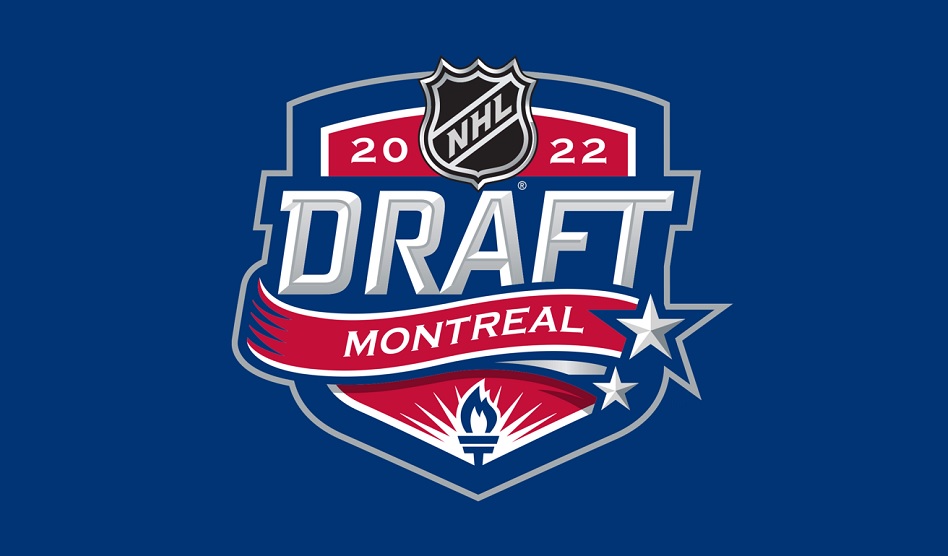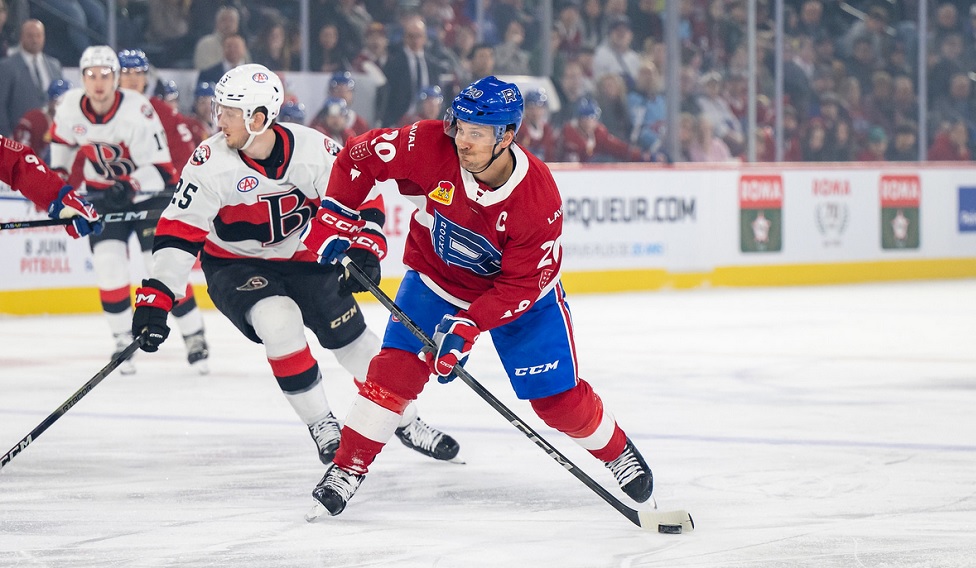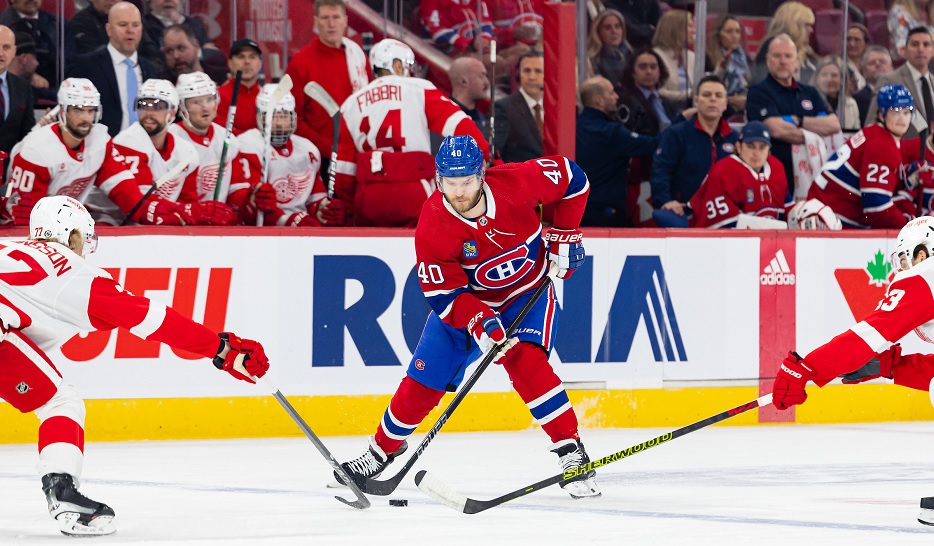HabsWorld.net --
Each National Hockey League team’s prospect pool has different strengths and weaknesses.
The Montreal Canadiens’ pool has a surplus of very good left-handed defencemen, some promising young forwards, and even a couple of under-the-radar European goaltenders who are trending up. The only thing keeping the Habs pool from being ranked with the best in the league is a lack of depth on right-handed defence.
Former GM Marc Bergevin and ex-director of amateur scouting Trevor Timmins made a start on addressing this deficiency at the 2021 NHL Entry Draft, adding right-handed defensemen Logan Mailloux at 31, Dimitri Kostenko at 87, and Daniil Sobolev with the 142nd pick to right-handed prospect depth that at the time consisted pretty much of just Josh Brook, taken in the second round in 2017.
While there’s always the chance that any of Montreal’s 2022 picks will be traded, if Habs GM Kent Hughes stands pat, the stars seem to be aligned for the Canadiens to add more quality right-handed defence to their system at the 2022 NHL Entry Draft in July. And they might not even need to use the 26th pick they got from Calgary to do it, as the two highest-ranked right-handed defencemen are guaranteed to go top ten or even top five, but the best of the rest who happen to shoot right are more likely to start coming off the board late in the first round and perhaps even early in the second.
With 14 picks in the draft, including a grouping of the 33rd, 62nd, 66th, and 75th picks in the second and third rounds to go with the late first from the Flames, there should be ample opportunity to draft one or more RHDs with NHL potential.
Here are an even dozen right-handed defencemen who could be available to the Canadiens at the draft, ranked in the order in which these players are likely to be selected.
Ryan Chesley, 6’, 195”, USNTDP: A top-four defender from the USNTDP’s U20 team, Chesley will be going the NCAA route in the fall, having committed to the University of Minnesota. A fine skater and good in transition, Chesley is also a physical player who is comfortable laying on the body. Add a nice shot selection and good hockey sense to the package and there’s no reason why the Minnesota native can’t come out of school after a couple of seasons and slide into a top-four role in the National Hockey League.
Seamus Casey, 5’10”, 165 lbs., USNTDP: Another top-four defenceman for the American U20 side, this Miami, Florida, native’s strengths are the strong skating and puck-handling skills which allow him to be effective in transition. A decent defender at the junior level, as a smaller defenceman in the NCAA, Casey will work on his defensive zone play with powerhouse Michigan next season as he continues to build his game. If all goes well, he should be at least a third-pairing defender in the NHL someday, but there’s a reasonable chance he can develop into something more.
Tristan Luneau, 6’2”, 174 lbs., Gatineau (QMJHL): A first overall pick in his QMJHL entry draft, the Trois-Rivieres native had knee surgery last offseason to correct a minor issue unrelated to hockey and it might have affected his play in the first part of the season. But skating is one of the few negatives in this two-way defender’s solid transition game, as he has excellent vision, can make a good first pass, and has a hard shot from the point. He probably will be a third-pairing defender as an NHLer, but perhaps the skating was being held back by the knee issue, which he apparently had for quite some time.
Sam Rinzel, 6’4”, 181 lbs., Chaska (Minnesota High School): This long and lean defender will join Chesley at the University of Minnesota right out of high school. While the NCAA is often tough for true freshmen, Rinzel’s well-rounded game should make the transition easier than most. A two-way defender who can transition the puck efficiently with his good speed and decent handling, his long arms also help make him an effective player in his own zone. It’s difficult to say where he will fit in an NHL lineup, but if all goes well in his time in the NCAA, top-four isn’t out of reach.
Maveric Lamoureaux, 6’7”, 196 lbs., Drummondville (QMJHL): One of the tallest skaters in the draft, the Hawkesbury, Ont., native is a surprisingly good skater for such a large man. With his boardinghouse reach, Lamoureaux is an efficient defender who has little trouble clearing the front of the net, but he also has a good pair of hands that can transition the pick effectively. There’s some intriguing top-four potential in his game, but he could also top out as a third-pairing guy. Where he gets selected in the draft will probably depend on which defenceman the team picking him sees.
Mattias Havelid, 5’10”, 170 lbs., Linkoping Jr. (Sweden): The twin brother of goaltender Hugo Havelid may be flying under the radar a bit as an undersized defenceman, but his strong offensive game will get him some attention on draft day. A strong skater with a blistering point shot and good passing ability, Havelid defends well for a smaller player and has had great success on the international stage, most recently picking up 12 points in six games in the U18 worlds. If he can handle the physical play in his own end, Havelid’s well-rounded game should get him to the NHL, at least in a third-pairing role.
Ty Nelson, 5’10”, 197 lbs., North Bay (OHL): A first-overall pick in the 2020 OHL entry draft, the Toronto native led the OHL in rookie defence scoring with 51 points. His biggest strength is his powerful skating and his biggest weakness is his lack of size when it comes time to handle large forwards in front of his own net. As an offensive player, Nelson has the skills to carry the puck up the ice and he is a good passer while his short but solid frame allows him to land some big hits as well, but his future likely depends on how well his defense translates to the NHL.
Noah Warren, 6’5”, 214 lbs., Gatineau (QMJHL): Another big man who skates well, what holds Warren back from first-round consideration is an undeveloped offensive game. His puck skills are nothing special at this stage of his career, but he has shown a hard shot on occasion and can be effective in transition. The Montreal native’s defensive game is sound enough to make him an attractive prospect but he’ll need to put in a lot of work on his offensive game if he hopes to compete for an NHL job one day.
Elias Salomonsson, 6’2”, 181 lbs., Skelleftea Jr.(Sweden): A solid two-way defenceman who makes a good first pass will always be in demand on draft day, but the rangy Swede’s point-a-game 16-year-old season wasn’t a true reflection of his offensive game and has led some to question his overall value in this his draft year. And though he’s not a particularly strong offensive player despite having a good shot and some passing abillity, his strong skating allows him to close gaps efficiently and angle skaters to the boards effectively. He could play a third-pairing role in the NHL.
Kasper Kulonummi, 5’11”, 180 lbs., Jokerit Jr. (Finland): Another puck-moving defenceman in the modern model, Kulonummi’s skating, hockey sense, and puck-handling are the parts of his game that allow him to be an efficient player in transition. And despite being a bit undersized, he’s proven to be reliable in his own end in international play as well as in the Finnish junior league, so his two-way game should project well into the pro ranks. But as an NHL defenceman, he probably tops out on the third pairing.
Christian Kyrou, 5’11”, 182 lbs., Erie (OHL): Jordan Kyrou’s little brother is what me and my friends back in the day used to refer to as an offenceman – a hockey player who lines up as a defender, but whose main focus is offence. Kyrou has great vision and is at his best running a power play, but at his size, he probably needs to be an elite skater, like his older brother, if he hopes to have a lengthy NHL career. He was one of the highest-scoring defencemen in the OHL this past season, collecting 18 goals and 42 assists.
Otto Salin, 5’11”, 192 lbs. HIFK (Finland) A series of injuries and illness kept the young blueliner on the shelf for part of last season, but when he was in the lineup he showed good offensive instincts as a reliable, puck-moving defenceman. Undersized, his troubles come mostly in the defensive end, but thoughts of the offensive upside he showed regularly as a 16-year-old will likely attract some attention on the second day of the draft. If Salin can develop a more reliable defensive game, his offensive gifts could see him on an NHL team’s third pairing.
With the rebuild/reset well underway in Montreal just one season after a Stanley Cup Final appearance shockingly followed by a last-place finish, it’s important that Hughes and the scouting team make some good picks from the 14 the team has gathered for the upcoming 2022 NHL Entry Draft.
With right-handed defence a clear weakness of the team’s prospect pool, it would be wise to use some of this draft capital to select some of the best ones available in the early rounds.


